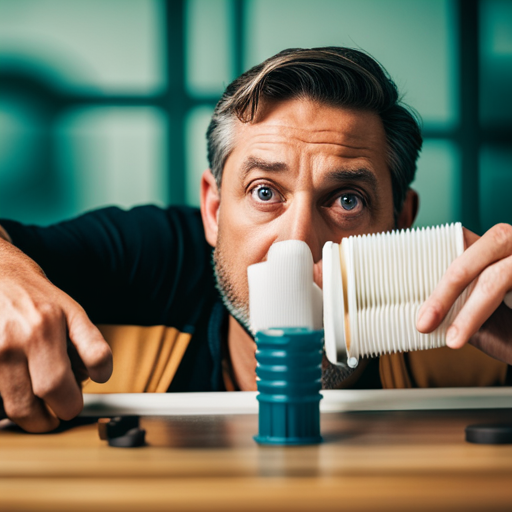Are you experiencing issues with your RO water purification system after replacing the filters? Are you frustrated with no water flow, low flow rate, or drainage problems? Don’t worry, you’re not alone.
Many homeowners face these filter change woes, but the good news is that they can be easily fixed with a little troubleshooting.
In this article, we’ll walk you through the basics of RO water purification systems and the common issues that arise after filter changes. We’ll also provide you with practical tips and solutions to help you get your system up and running smoothly again.
So, sit back, relax, and let’s dive into the world of RO filter change woes.
Key Takeaways
– Reverse osmosis (RO) water purification systems can have issues after filter change that result in no water flow, low flow rate, or low water level in storage tank.
– These issues can be caused by incorrect air pressure, low water pressure, a turned-off saddle valve, drainage issues, clogging of filters and membrane, poor quality of domestic water from main line, and ruptured RO tank bladder.
– To troubleshoot these issues, homeowners should turn on saddle valve and storage tank valve, ensure minimum water pressure of 40 PSI, sterilize or replace filters, and call water treatment experts for thorough inspection if no water issue persists.
– Homeowners should also have mainline water and reverse osmosis water tested immediately in case of impurities and be aware of the lifespan of the filters and membrane, which typically last for 9 months to a year depending on consumption.
RO Water Purification Basics
If you’re familiar with reverse osmosis (RO) water purification systems, you know they can eliminate up to 99% of impurities in tap water. They require filter changes once or twice a year and produce 2-3 ounces of purified water per minute. However, they can experience issues after filter changes such as no water flow, low flow rate, or drainage issues.
Proper RO filter maintenance is essential to ensure a continuous supply of clean and safe water. It’s also important to regularly test the water quality of your mainline water and RO water to detect any impurities. RO filters should be replaced once or twice a year, depending on consumption. If you notice a decrease in water flow or quality, it may be time to replace your filters.
It’s also important to sterilize or replace your filters on your own to avoid any issues. Regularly testing the water quality of your mainline water and RO water can help you detect any impurities or contaminants that may be affecting the performance of your RO system. By following these maintenance tips, you can ensure a continuous supply of clean and safe water from your RO system.
Common Filter Change Issues
One common issue when replacing your reverse osmosis filters is a low flow rate, which may be caused by a clogged membrane or poor water pressure. To avoid this, it’s important to perform regular filter maintenance and ensure that your water pressure is at least 40 PSI.
Poor quality of domestic water from the main line can also cause clogging of filters and the membrane, so it’s essential to have your mainline water and reverse osmosis water tested immediately in case of impurities.
In addition to these issues, it’s crucial to turn on both the saddle valve and storage tank valve after a filter change to ensure proper water flow. If you’re still experiencing no water flow after following these steps, it’s recommended to call a water treatment expert for a thorough inspection.
By taking care of your reverse osmosis system and addressing any issues promptly, you can ensure that you have access to clean, healthy, and safe water for your home.
Troubleshooting and Solutions
To troubleshoot and solve any issues with your reverse osmosis water purification system, follow these simple steps:
– First, check the air pressure of your storage tank and make sure it’s set at the recommended level. If it’s not, adjust it accordingly. Incorrect air pressure can cause drainage issues and lead to low water flow rate.
– Next, if you’re experiencing clogging of filters and membrane, it may be due to poor quality of domestic water from the main line. In such cases, you may need to install a booster pump to ensure the pressure remains over 40 PSI. This will help prevent any future clogging and ensure proper water flow.
– If you’ve already installed a booster pump and are still having issues, then it may be time to replace the storage tank.
– Always remember to turn on the saddle valve and storage tank valve after a filter change, and have your mainline water and reverse osmosis water tested immediately in case of impurities.
– If the issue persists, it’s best to call in a water treatment expert for a thorough inspection.
Conclusion
So, you’ve experienced no water flow, low flow rate, or drainage issues after replacing your RO filters. Don’t worry, it’s a common problem that can be easily fixed.
As we’ve discussed in this article, there are seven reasons for these filter change woes, and we’ve provided tips on how to troubleshoot and solve them.
Remember, it’s important to regularly test your water and replace your RO filters to ensure clean and safe water for you and your family. And if you ever feel unsure or overwhelmed, don’t hesitate to call in a water treatment expert.
With these tips and a little bit of troubleshooting, you’ll be enjoying the benefits of clean and healthy water in no time.




